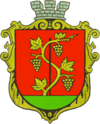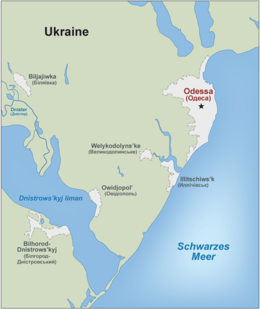Bilhorod-Dnistrovskyi
| Bilhorod-Dnistrovskyi | ||
| Білгород- Дністровський | ||

|
|
|
| Basic data | ||
|---|---|---|
| Oblast : | Odessa Oblast | |
| Rajon : | District-free city | |
| Height : | no information | |
| Area : | 31 km² | |
| Residents : | 50,086 (2015) | |
| Population density : | 1,616 inhabitants per km² | |
| Postcodes : | 67719 | |
| Area code : | +380 4849 | |
| Geographic location : | 46 ° 12 ′ N , 30 ° 21 ′ E | |
| KOATUU : | 5110300000 | |
| Administrative structure : | 1 city, 2 SsT | |
| Mayor : | Mykola Dazenko | |
| Address: | вул. Леніна 56 67701 м. Білгород-Дністровський |
|
| Statistical information | ||
|
|
||
Bilhorod-Dnistrovskyi ( Ukrainian Білгород-Дністровський ; Russian Белгород-Днестровский / Belgorod-Dnestrowski , romanian Cetatea Albă, Turkish Akkerman , German outdated and White Castle ) is a city in the Odessa Oblast in southwestern Ukraine . It is the center of the Rajons of the same name and a port city on the Dnister Liman , 18 kilometers from the Black Sea . The city has 50,000 inhabitants (2015) and belonged to the historical region of Bessarabia . It is divided into the city proper and the two urban-type settlements Satoka and Serhiyivka .
history
In the sixth century BC The colony of Tyras of the Ionian city of Miletus was founded on the site of the present city , which lasted until the fourth century BC. Existed. Nearby settled Getic and Dacian tribes, to the large group of Thracians belong, and Scythian and Sarmatian . In the first century BC The area was part of the empire of Burebista .
The territory of the Dacians was conquered by the Romans in 105 through Trajan in order to establish the province of Dacia there. The city later became a base for the Roman fleet . At the mouth of the Dniester (ancient Tyras , Latin Dniester / Aestuaris ) lived the Dacian-Getic tribe of the Tyragetae . The Roman territory did not include this area at that time, but Roman coin finds in the area of the present-day city of Bilhorod-Dnistrovskyi prove Roman influence. A Roman inscription found proves that the place was a free port at that time.
During the barbarian invasions destroyed the city later by the was ostslawischen tivertsi under the name Belgorod ( "White City") rebuilt by Polowzians and Tatars but destroyed. Genoese rebuilt it under the name Maurocastro after the Nymphaion Agreement (1261) . The city then became a Moldovan trading metropolis (during this time the Moldovan Prince Stefan the Great expanded the fortress into an important military base), which was not conquered by Sultan Bayezid II until 1484, together with Kilija, as the last non-Ottoman Black Sea port. Some of the inhabitants were deported to Constantinople .
In 1812 Akkerman, like all of Bessarabia, became permanently part of Russia through the Treaty of Bucharest . In 1904 a horse-drawn tram opened its operations and ran it until 1930. On January 2, 1916, the city was connected to the railway network with the opening of the Leipzig – Akkerman railway line.
After the revolution in 1918, the city became Romanian through the national self-determination of Bessarabia . Occupied by the Soviet Union in 1940 and incorporated into the Ukrainian Soviet Republic (briefly capital of Akkerman Oblast in 1940 , later Ismajil Oblast ), occupied by Romanians in 1941–1944 after the German invasion of the Soviet Union and again Soviet and again in 1944 with the advance of the Red Army Part of the Ukrainian Soviet Republic of the USSR. In 1991, after the dissolution of the Soviet Union and the declaration of independence of Ukraine, the city remained Ukrainian as part of Odessa Oblast.
Akkerman Fortress from the Liman
Historical names
Historically and in other languages, the city was also known as: Greek Asprokastron or Maurokastron , Latin Mauro-, Moncastrum and Romanian Cetatea Albă . In the Slavic documents the city is called Bialgorod ("White City"), in Hungarian it is called Dnyeszterfehérvár ("White City on the Dniester"). In the 15th century, as well as between 1918 and 1940 and from 1941 to 1944, the city bore the official Romanian name Cetatea Albă . From 1503 to 1918 and from 1940 to 1941 the city was called Akkerman (Аккерман) ( Turkish for "White Rock"). From 1944 to 1991 the city was called in Russian Belgorod-Dnestrovsky (Белгород-Днестровский).
Akkerman gained political fame through the Treaty of Akkerman concluded between Russia and the Sublime Porte on October 6, 1826 , the failure of which on the part of the Porte to lead to the Russo-Turkish War of 1828.
population
| year | 1897 | 1989 | 2001 | 2015 |
|---|---|---|---|---|
| Residents | 28,258 | 55,631 | 51,890 | 50,086 |
Source: 1989–2012
Ukrainians (53.7%), Russians (20.3%) and Jews (19.7%) were the largest ethnic groups around 1900. The minorities included 2.1% Armenians , 1.0% Bulgarians , 0.8% Romanians , 0.8% Germans and 0.6% Poles .
In 2001, 62.9% Ukrainians, 28.2% Russians, 3.7% Bulgarians, 1.9% Romanians, 0.6% Belarusians , 0.4% Gagauz , 0.3% Jews, 0.3% Armenians lived here and 0.3% Sinti and Roma .
sons and daughters of the town
- Morris Sigman (1880–1931), American trade unionist
- Maxim Karolik (1893–1963), American tenor, actor and art collector
- Viktor Yarosevich (1909–2002), Soviet rear admiral
- David Malkin (1910–2002), French painter
- Anatoly Jazkow (1913–1993), Soviet diplomat
- Baruch Kamin (1914–1988), Israeli politician
- Nicolae Văcăroiu (* 1943), Romanian politician
- Anatoly Lomatschenko (* 1964), boxing trainer
- Tatjana Turanskaja (* 1972), Transnistrian politician
- Vitaly Tschuhunnikow (* 1974), politician
- Wassyl Lomatschenko (* 1988), boxer
literature
- Sergej Udowik: Ukraine. Historic places . Wakler-Verlag Kiev 2010, ISBN 978-966-543-102-2 ; Pp. 100-101.
- Article in the Neue Zürcher Zeitung about Bessarabia: [2]
Web links
- City history of Tire
- City history of Bilhorod-Dnistrovskyi
- Photo of the Akkerman Fortress ( Memento from May 23, 2016 in the Internet Archive )
Individual evidence
- ↑ a b [1]
- ^ The Russian year-book 1916, p. 265
- ^ John Kaba: Politico-economic Review of Basarabia . American Relief Administration, United States 1919, p. 15.






